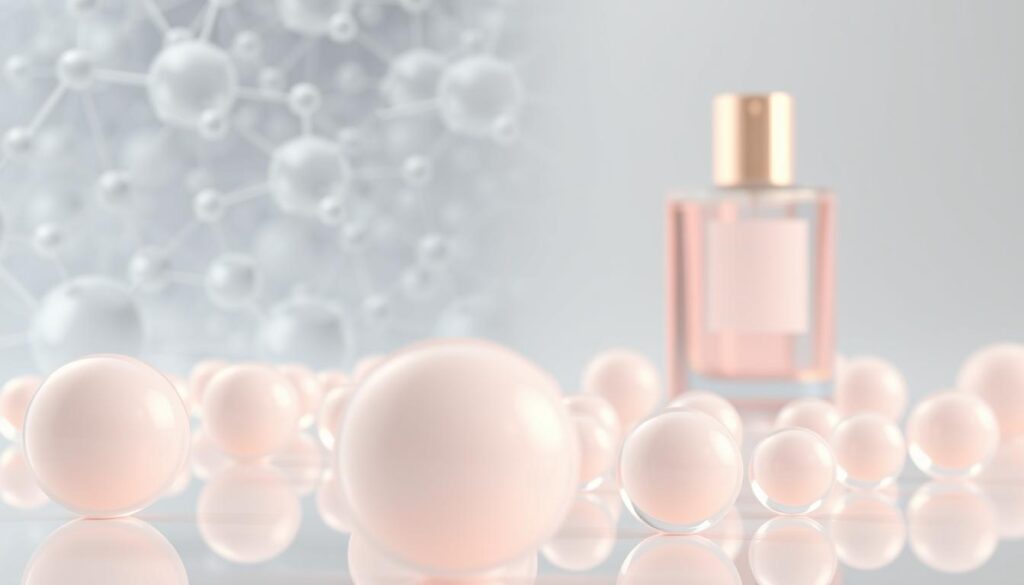Imagine a world where skincare ingredients can reach deeper and work better than ever. Nanoparticles are changing the game in skincare, offering new ways to deliver ingredients. These tiny particles, smaller than 100 nm, are a game-changer for skin health1.
The nanotechnology market in skincare is booming. It’s expected to hit over $125 billion by 20241. Nanoparticles make it easier for your skin to absorb and use important nutrients and treatments.
Your skincare routine is about to get a high-tech boost. Nanoparticles can be added to creams, lotions, anti-aging products, and sunscreens1. They help keep ingredients stable, improve how they penetrate, and control how they interact with your skin1.
Key Takeaways
- Nanoparticles enable unprecedented targeted delivery in skincare
- Microscopic particles can penetrate skin more effectively than traditional ingredients
- Nanotechnology market in cosmetics expected to reach $125 billion by 2024
- Nanoparticles improve ingredient stability and absorption
- Advanced delivery systems promise more efficient skincare treatments
Understanding the Fundamentals of Skin Structure and Permeation
Your skin is a complex and remarkable organ that serves as the body’s primary protective barrier. It is designed to shield you from external threats while maintaining internal balance2.
The Multilayered Skin Architecture
The human skin has three primary layers, each with unique characteristics and functions:
- Epidermis: The outermost protective layer
- Dermis: Contains connective tissues and vital structures
- Hypodermis: Composed of fat and connective tissue
The stratum corneum, the uppermost sublayer of the epidermis, plays a critical role in skin permeation. Its thickness ranges between 10-20 μm, creating a formidable barrier against external substances2.
Barriers to Ingredient Penetration
Your skin’s defense mechanism makes it hard for ingredients to penetrate. The stratum corneum’s lipid layer, made of ceramides, cholesterol, and fatty acids, acts as a nearly impenetrable shield2. Skincare technologies must overcome these complex barriers to deliver active ingredients3.
| Skin Layer | Thickness | Key Components |
|---|---|---|
| Epidermis | 100-150 μm | Keratinocytes, Melanocytes |
| Dermis | 1200 μm | Connective Tissue, Blood Vessels |
| Stratum Corneum | 10-20 μm | Ceramides, Cholesterol, Fatty Acids |
Natural Penetration Pathways
Despite its protective nature, skin offers subtle pathways for substance absorption. Hair follicles and sweat ducts provide minimal yet significant routes, accounting for just 0.1% of total skin surface area2. Nanotechnology is revolutionizing our ability to leverage these natural penetration mechanisms3.
Understanding these fundamental skin characteristics is crucial for developing advanced skincare delivery systems. These systems aim to effectively transport active ingredients through this complex biological barrier.
The Evolution of Skincare Delivery Systems
Skincare has changed a lot in recent years. We’ve moved from simple lotions to advanced nanocarriers. These new systems help active ingredients reach deeper into the skin4. The cosmetic world has quickly adopted nanotechnology, making skincare more effective and precise4.
Older skincare used basic formulas with big problems. These products had trouble with:
- Inconsistent ingredient absorption
- Limited penetration into deeper skin layers
- Greasy textures that felt uncomfortable5
Nanocarriers changed the game for skincare. They bring big benefits, like:
- High biocompatibility
- Low cytotoxicity
- Enhanced stability of active ingredients5
Nanotechnology lets scientists make targeted delivery systems. These systems can carry skincare ingredients exactly where they need to go. The International Organization for Standardization says nanoscale is about 1-100 nm, making delivery super precise4.
The move from old skincare to new nano-enhanced formulas is huge. Now, you can find skincare products that work better, more efficiently, and are made just for you.
Nano-Delivery Systems: The Future of Targeted Skincare Ingredient Penetration
Skincare technology is changing fast with nanocarriers and targeted delivery systems. These tiny innovations change how active ingredients work on your skin. They bring new precision to skincare nanotechnology6.
Core Principles of Nano-Delivery Technologies
Nanocarriers are advanced molecular tools that help ingredients get into your skin better. They are tiny, smaller than 500 nanometers. This lets them move through skin layers with great ease6.
- Penetrate deeper skin layers
- Protect sensitive active ingredients
- Improve ingredient stability
- Enhance targeted delivery
Types of Nano-Delivery Technologies
Today’s skincare uses many nano-delivery technologies, including:
| Technology | Key Characteristics |
|---|---|
| Microemulsions | Enhanced ingredient solubility |
| Nanoemulsions | Improved skin penetration |
| Liposomes | Excellent encapsulation properties |
| Nanoparticulate Carriers | Precise ingredient targeting |
Advantages Over Traditional Methods
Nano-delivery systems are better than old skincare methods. They keep vitamins and antioxidants safe and effective6. The global nanomaterials cosmetics market is growing fast, reaching USD 8.5 billion in 2019. It’s expected to grow 13.1% each year7.
Using skincare nanotechnology means better, more focused skincare. It changes your skincare routine for the better7.
Liposomal Technology in Skincare Applications
Liposomal technology has changed skincare by offering a new way to use ingredients. These tiny vesicles help active compounds get into your skin8. Liposomes can carry both water-loving and water-fearing ingredients, making them great for skincare9.
The main benefits of liposomal technology are:
- Ingredients penetrate better
- Active compounds stay stable longer
- Less skin irritation
- Ingredients are delivered more precisely
Studies show that liposomes between 50-500 nm work best for skincare10. This size helps them absorb well and work effectively. Nanoencapsulation keeps delicate ingredients safe and lets them reach deeper skin layers8.
Using liposomal technology in your skincare can make products more effective. Liposomes protect ingredients and help them get into your skin better9.
Liposomal technology is a big step forward in skincare. It changes how active ingredients work with your skin.
Polymeric Nanoparticles and Their Role in Skin Penetration
Skincare technology has changed how active ingredients get to your skin’s deepest layers. Polymeric nanoparticles are a new way to deliver ingredients, giving you better skin penetration11.
These tiny carriers are between 10 nm and 1000 nm in size11. They release active ingredients slowly, making sure they work well and don’t go to waste.
Structure and Innovative Properties
Polymeric nanoparticles are mainly two types:
- Nanospheres: Solid matrix particles
- Nanocapsules: Vesicular systems with a hollow center
Their design lets them hold both water-loving and fat-loving compounds. This makes them very useful for skincare11.
Benefits for Active Ingredient Delivery
The main benefits of polymeric nanoparticles are:
- They help active ingredients get into the skin better
- They release ingredients slowly
- They protect sensitive compounds
- They target specific skin layers
Current Applications in Skincare
Researchers are looking into new uses for polymeric nanoparticles. They’ve found that hydrogel formulas with these particles can help with skin conditions like psoriasis11. They’re also studying how to use them for targeted treatments in skin research11.
As skincare keeps getting better, polymeric nanoparticles will change how ingredients work with your skin. They promise more efficient and precise ways to deliver them.
Solid Lipid Nanocarriers (SLNs) in Modern Skincare

Solid lipid nanocarriers are changing the game in skincare. They help active ingredients get into the skin better. These tiny carriers are making UV protection and targeted delivery more effective12.
They are small, between 50-100 nm, which lets them get through the skin’s layers easily13.
These carriers are special in skincare. They have many benefits:
- They keep ingredients stable
- They help ingredients get into the skin better
- They release active compounds slowly
- They target specific skin layers
For UV protection, solid lipid nanocarriers are a smart choice. They can hold sunscreen agents, giving better and longer protection14. The lipid-based drug delivery systems make sunscreen work better and cause less irritation.
Studies show solid lipid nanocarriers boost skincare product performance. They can carry both oily and water-loving compounds, making them great for complex formulas12.
The future of skincare is about smart, targeted delivery systems that tackle specific skin issues.
Skincare brands are using solid lipid nanocarriers to create better, more focused products. These products offer better protection and treatment14.
Nanoemulsions: Advanced Delivery Solutions
Nanoemulsions are a new way to make skincare better. They use tiny oil droplets in water to help ingredients get into your skin better15.
Formation and Unique Characteristics
Nanoemulsions are very small, smaller than 100 nanometers15. They have special features that make your skin care work better:
- They are stable and don’t break down easily
- They help ingredients get into your skin better
- They are safe and don’t irritate your skin
Stability and Efficacy Factors
How well nanoemulsions work depends on a few things. To get into your skin well, ingredients need to be the right size and type15. Good ingredients for skin care are:
- Lighter than 500 Da
- Have a logP between 1-3
- Have a low polydispersity (under 10%)
Clinical Applications
Nanoemulsions are showing great promise in real-world use. Studies have shown they help drugs get into the skin better for many things15. For example, caffeine in nanoemulsion form gets into the skin much better than usual methods. This makes it more effective.
Nanoemulsions are the future of targeted skincare ingredient delivery, offering unprecedented precision and efficacy.
These advanced solutions could change your skincare routine. They help your skin absorb ingredients more effectively16.
Gold and Silver Nanoparticles in Skincare Innovation

Metal nanoparticles are changing the skincare world. They bring new ways to fight bacteria and reduce signs of aging. Gold and silver nanoparticles are leading this change, making skincare products work better17. The use of nanotechnology in skincare is growing fast, with big market increases expected18.
These metal nanoparticles are great at carrying skincare ingredients. Gold nanoparticles can be 5 to 400 nm in size, making them versatile for delivering ingredients17. They have special qualities like:
- Exceptional stability
- Biocompatibility
- Non-toxic cellular interactions
- Enhanced ingredient penetration
Silver nanoparticles also have benefits for fighting bacteria in skincare. Studies show they can stop bacteria from growing17. They can also keep cosmetic formulas stable for over a year, which is great for new skincare products18.
The market for nanotechnology in skincare is growing. It has promising uses for issues like wrinkles, dry skin, and dark spots17. People want skincare that is backed by science and uses metal nanoparticles18.
Safety Considerations and Regulatory Guidelines
Understanding nanoparticle safety is complex. It involves knowing current laws and new research. The skincare world leads in using nanotechnology. It must follow strict safety rules to keep customers safe.
- Clear definition of nanomaterials at the molecular level19
- Tests before products hit the market19
- Labels must be detailed19
Current Safety Research Landscape
Research into nanotoxicology shows big challenges. Scientists are still figuring out how nanoparticles affect our bodies. They focus on exposure assessment and health risks20. There’s a lot they don’t know yet20.
Regulatory Framework
The Cosmetic Regulation has strict rules for nanomaterials. It requires thorough checks before products are sold19. The European Commission has clear rules for what counts as a nanomaterial19.
Future Safety Protocols
Scientists are working on better ways to test safety. They want to find reliable methods to study how nanoparticles interact with our bodies20. Their goal is to keep customers safe while still pushing skincare innovation.
The future of nanoparticle safety lies in collaborative, interdisciplinary research and adaptive regulatory frameworks.
The Future of Nano-Delivery Systems in Skincare
Nanotechnology is changing skincare fast. New delivery systems are making active ingredients work better on your skin21. The market for nanotechnology in skincare is growing fast, with a 12% increase expected from 2021 to 202621.
Personalized skincare is getting closer thanks to nano-delivery systems. Scientists found that nanoparticles can make skin absorb ingredients up to 80% better21. Clinical trials show nanoemulsions can boost drug effectiveness by 30-50%, making treatments more precise21.
Nanoparticles are making treatments more effective by improving how ingredients reach the skin22. About 70% of dermatologists are already using nanotechnology in their products21. This means the future of skincare is looking more personalized and advanced.
FAQ
What are nano-delivery systems in skincare?
How do nano-delivery systems differ from traditional skincare formulations?
Are nano-delivery systems safe for skincare use?
What types of nano-delivery technologies exist in skincare?
Can nano-delivery systems improve the effectiveness of skincare ingredients?
What are liposomes in skincare?
How do nanoemulsions work in skincare products?
Are there any specific benefits of using gold or silver nanoparticles in skincare?
What regulatory considerations exist for nano-delivery systems?
What is the future potential of nano-delivery systems in skincare?
Source Links
- Delivery systems in nanocosmeceuticals – https://www.degruyter.com/document/doi/10.1515/rams-2022-0282/html?srsltid=AfmBOopry5wjjeHDIfFnuBtmPMT4ruUZWNhNAL5xpi_UD8LJwp3v2Y2J
- Functional nano-systems for transdermal drug delivery and skin therapy – https://pmc.ncbi.nlm.nih.gov/articles/PMC10012846/
- Frontiers | Enhancing Permeation of Drug Molecules Across the Skin via Delivery in Nanocarriers: Novel Strategies for Effective Transdermal Applications – https://www.frontiersin.org/journals/bioengineering-and-biotechnology/articles/10.3389/fbioe.2021.646554/full
- Nanosystems in Cosmetic Products: A Brief Overview of Functional, Market, Regulatory and Safety Concerns – https://pmc.ncbi.nlm.nih.gov/articles/PMC8470546/
- Advancements in nanoparticles for skin care: a comprehensive review of properties, applications, and future perspectives – Discover Materials – https://link.springer.com/article/10.1007/s43939-024-00088-4
- Delivery systems in nanocosmeceuticals – https://www.degruyter.com/document/doi/10.1515/rams-2022-0282/html?srsltid=AfmBOopUnGGYLWQHrsK8fNcQnVCfaavO4YXGYY7nx5u0dZofyKeY_Z80
- Nanotechnology in Cosmetics and Cosmeceuticals—A Review of Latest Advancements – https://www.mdpi.com/2310-2861/8/3/173
- Delivery systems in nanocosmeceuticals – https://www.degruyter.com/document/doi/10.1515/rams-2022-0282/html?srsltid=AfmBOopoO_VxVhXkSv3JzRAvWZQDJy9KoVn8VYHkFWF33P12Q0hUFLUL
- Nano based drug delivery systems: recent developments and future prospects – Journal of Nanobiotechnology – https://jnanobiotechnology.biomedcentral.com/articles/10.1186/s12951-018-0392-8
- Liposomal Nanocarriers to Enhance Skin Delivery of Chemotherapeutics in Cancer Therapy – https://www.mdpi.com/2306-5354/12/2/133
- Nanocarriers and nanoparticles for skin care and dermatological treatments – https://pmc.ncbi.nlm.nih.gov/articles/PMC3853888/
- Lipid Nanoparticulate Drug Delivery Systems: Recent Advances in the Treatment of Skin Disorders – https://pmc.ncbi.nlm.nih.gov/articles/PMC8619682/
- Optimization of Solid Lipid Nanoparticle Formulation for Cosmetic Application Using Design of Experiments, PART II: Physical Characterization and In Vitro Skin Permeation for Sesamol Skin Delivery – https://www.mdpi.com/2079-9284/11/4/120
- Current Advances in Lipid Nanosystems Intended for Topical and Transdermal Drug Delivery Applications – https://pmc.ncbi.nlm.nih.gov/articles/PMC9967415/
- Topical Nano and Microemulsions for Skin Delivery – https://pmc.ncbi.nlm.nih.gov/articles/PMC5750643/
- Delivery systems in nanocosmeceuticals – https://www.degruyter.com/document/doi/10.1515/rams-2022-0282/html?srsltid=AfmBOoozAvni9EnG9M3qSW8AJ9b_H3X0H4NyIoZnHVexkvQ8WqjTuEKE
- Nanotechnology in Cosmetics and Cosmeceuticals—A Review of Latest Advancements – https://pmc.ncbi.nlm.nih.gov/articles/PMC8951203/
- Nanomaterials for Skin Delivery of Cosmeceuticals and Pharmaceuticals – https://www.mdpi.com/2076-3417/10/5/1594
- Microsoft Word – SCCS Nano Guidance_Proof-read version 03.11.2019.docx – https://health.ec.europa.eu/system/files/2020-10/sccs_o_233_0.pdf
- Opinion of the Scientific Committee on Consumer Products on the safety of nanomaterials in cosmetic products – https://ec.europa.eu/health/ph_risk/committees/04_sccp/docs/sccp_o_123.pdf
- Exploring the Potential of Nanocarriers for Targeted Delivery of Anti-acne Agents: A Review – https://www.eurekaselect.com/article/134159
- Recent Progress and Future Directions: The Nano-Drug Delivery System f | IJN – https://www.dovepress.com/recent-progress-and-future-directions-the-nano-drug-delivery-system-fo-peer-reviewed-fulltext-article-IJN




